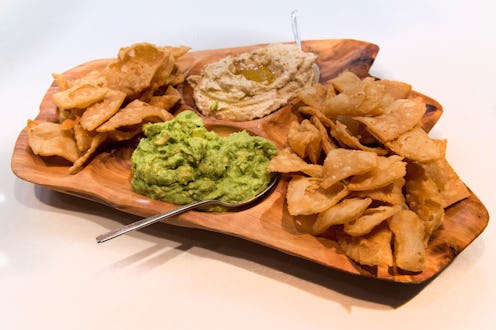Life
5 Health Foods You're Screwing Up

In a desperate scramble to satisfy a late-night craving last weekend, my roommate and I polished off a tub of hummus. Feeling quite accomplished that we bypassed the go-to pizza delivery, our gratification quickly fizzled when we looked at the label and realized that the entire container boasted more calories than a proper meal.
Chickpeas, you deceptive little beans.
It's moments like these that can have us a bit confused about foods deemed "good-for-you." In addition to hummus, there are a ton of health foods that, yes, do have stellar nutrients, but should be assessed with caution, whether it's figuring out portions, scoping labels for sneaky bad ingredients, or just eating the right food combinations.
Bustle chatted with nutritionist Esther Blum, M.S., author of Cavewomen Don't Get Fat, to get the scoop on the five trickiest health foods, plus how to max out their benefits. Because if you're gonna skip the pizza and opt for a kale salad, you wanna do it right, amirite?
Hummus
Scroll through any "best healthy foods" list and hummus almost always makes the cut. And what's not to love? It's packed with protein, fiber, and healthy fats and way better for you than, say, classic onion dip. But you'll want to watch the ingredients list if you are buying it pre-made.
"Real hummus is made with only a couple of ingredients: chickpeas, olive oil, tahini, lemon juice, plus garlic, and other spices if you wish. Examine store labels closely and look for dips without canola or soybean oil, which can hike up inflammation in the body," Blum says. Also, portions are key. Stick to a quarter cup serving since calories add up quickly. It's meant to be a snack, not a meal replacement. (Lesson learned.)
Nut Butter
Another protein-packed snacking favorite, you'll want to watch your portions with this spread. Limit to just two tablespoons daily (because it's easy to dip through an entire jar, trust us, we've done it). Blum also notes that the best butters are ground fresh in store and free of added sugar and hydrogenated oils.
"Nut butter, especially peanut butter, has really gotten a lot of backlash recently, but as long as you're buying it as natural as possible, it's a filling and healthy snack," she says.
Salad
The thinking goes, if you're eating a salad, you're already #winning. And yes, while loading up on greens is way better than grabbing a ham and cheese on white bread, you want to make sure you're making the most of it.
"When you're eating greens, you need something fat to go along with it, like, olive oil, avocado, or nuts. Greens have fat-soluble vitamins like vitamin K and beta-carotene that are better absorbed when taken together with a fat. Otherwise the vitamins aren't making it into your bloodstream," Blum explains.
Probiotic Yogurt
Microbes are all the rage now. Gut-friendly, skin boosting, digestive-system firing, these minuscule particles can really boost well-being. Probiotics are naturally occurring in fermented foods such as pickles, sauerkraut, and kimchi, but can also be thrown into yogurt, kefir, and soy milk. But they might not be doing you a favor.
"The problem with products that have added probiotics is that they are also generally packed with sugar. Sugar essentially diminishes the effects of probiotics because it encourages the growth of yeast in the gut," Blum says. If you're set on giving your intestinal flora a boost, your best bet is to stick to fermented varieties.
Granola
You see it at almost every health store, but this blend of grains comes with hidden baggage: It's often chock-full of sugar. One serving will often have upwards of 40 grams of white stuff, which is almost twice the daily amount recommended by the World Health Organization.
"It's not a great way to start the morning. You want to have a meal balanced with protein and fat to wake up your brain and get neurons firing. This is just a sugar bomb," says Blum.
Too keen on granola to give it up? Scour the label to make sure there is no more than 10 grams of sugar per serving, max.